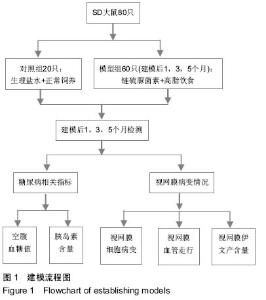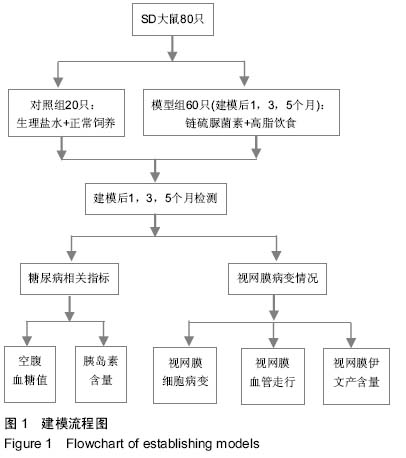| [1] Vidhya G, Anusha B. Diaretinopathy database -A Gene database for diabetic retinopathy. Bioinformation. 2014;10(4): 235-240.
[2] Hartstra W W, Holleman F, Hoekstra JB, et al. Screening for diabetic retinopathy. Ned Tijdschr Geneeskd. 2007;151(4): 228-233.
[3] Ibrahim MA, Annam RE, Sepah YJ, et al. Assessment of oxygen saturation in retinal vessels of normal subjects and diabetic patients with and withoutretinopathy using Flow Oximetry System. Quant Imaging Med Surg. 2015;5(1):86-96.
[4] 许迅,邹海东.糖尿病视网膜病变的社区筛查和防治[J].中国眼耳鼻,2008,(5):276-279.
[5] Rakieten N, Rakieten ML, Nadkarni M V. Studies on the diabetogenic action of streptozotocin (NSC-37917). Cancer Chemother Rep. 1963;29:91-98.
[6] 施沃栋,王志良,罗敏,等.链脲佐菌素诱发糖尿病大鼠模型视网膜形态学改变的观察[J].眼科新进展,2008,(8):583-585.
[7] Lupi R, Dotta F, Marselli L, et al. Prolonged exposure to free fatty acids has cytostatic and pro-apoptotic effects on human pancreatic islets: evidence that beta-cell death is caspase mediated, partially dependent on ceramide pathway, and Bcl-2 regulated. Diabetes. 2002;51(5):1437-1442.
[8] Buch H, Vinding T, Nielsen NV. Prevalence and causes of visual impairment according to World Health Organization and United States criteria in an aged, urban Scandinavian population: the Copenhagen City Eye Study. Ophthalmology. 2001;108(12):2347-2357.
[9] Chernykh VV, Varvarinsky EV, Smirnov EV, et al. Proliferative and inflammatory factors in the vitreous of patients with proliferative diabetic retinopathy. Indian J Ophthalmol. 2015; 63(1):33-36.
[10] Threatt J, Williamson JF, Huynh K, et al. Ocular disease, knowledge and technology applications in patients with diabetes. Am J Med Sci. 2013; 345(4):266-270.
[11] 梁海霞,原海燕,李焕德,等.高脂喂养联合低剂量链脲佐菌素诱导的2型糖尿病大鼠模型稳定性观察[J].中国药理学通报,2008,(4): 551-555.
[12] Srinivasan K, Viswanad B, Asrat L, et al. Combination of high-fat diet-fed and low-dose streptozotocin-treated rat: a model for type 2 diabetes and pharmacological screening. Pharmacol Res. 2005;52(4):313-320.
[13] Ulas M, Orhan C, Tuzcu M, et al. Anti-diabetic potential of chromium histidinate in diabetic retinopathy rats. BMC Complement Altern Med. 2015;15(1):16.
[14] Shinde UA, Goyal RK. Effect of chromium picolinate on histopathological alterations in STZ and neonatal STZ diabetic rats. J Cell Mol Med. 2003;7(3):322-329.
[15] Sreejayan N, Dong F, Kandadi MR, et al. Chromium alleviates glucose intolerance, insulin resistance, and hepatic ER stress in obese mice. Obesity. 2008;16(6):1331-1337.
[16] Matthews DR, Hosker JP, Rudenski AS, et al. Homeostasis model assessment: insulin resistance and beta-cell function from fasting plasma glucose and insulin concentrations in man. Diabetologia. 1985;28(7):412-419.
[17] 韩冰,李璇,梁国强,等.STZ-CFA加饲高脂诱导的糖尿病大鼠模型及其眼病特点[J].眼科新进展,2005,(4):328-330.
[18] Sayin N, Kara N, Pekel G. Ocular complications of diabetes mellitus. World J Diabetes. 2015;6(1):92-108.
[19] Giansanti R, Rabini RA, Romagnoli F, et al. Coronary heart disease, type 2 diabetes mellitus and cardiovascular disease risk factors: a study on a middle-aged and elderly population. Arch Gerontol Geriatr. 1999;29(2):175-182.
[20] Yan Z, Liu Y, Huang H. Association of glycosylated hemoglobin level with lipid ratio and individual lipids in type 2 diabetic patients. Asian Pac J Trop Med. 2012;5(6):469-471.
[21] Antonetti DA, Barber AJ, Bronson SK, et al. Diabetic retinopathy: seeing beyond glucose-induced microvascular disease. Diabetes. 2006;55(9):2401-2411.
[22] Thangaraju P, Chakrabarti A, Banerjee D, et al. Dual blockade of Renin Angiotensin system in reducing the early changes of diabetic retinopathy and nephropathy in a diabetic rat model. N Am J Med Sci. 2014;6(12):625-632.
[23] Obrosoca IG, Kador PF. Aldose reductase/polyol inhibitors for diabetic retinopathy. Curr Pharm Biotechnol. 2011;12(3):373-385.
[24] Madsen-Bouterse SA, Kowluru RA. Oxidative stress and diabetic retinopathy: pathophysiological mechanisms and treatment perspectives. Rev Endocr Metab Disord. 2008;9(4): 315-327.
[25] Hegde KR, Varma SD. Combination of glycemic and oxidative stress in lens: implications in augmentation of cataract formation indiabetes. Free Radic Res. 2005;39(5):513-517.
[26] Thiraphatthanavong P, Wattanathorn J, Muchimapura S, et al. The combined extract of purple waxy corn and ginger prevents cataractogenesis and retinopathy instreptozotocin- diabetic rats. Oxid Med Cell Longey. 2014.
[27] Lara-Castillo N, Zandi S, Nakao S, et al. Atrial natriuretic peptide reduces vascular leakage and choroidal neovascularization. Am J Pathol. 2009;175(6):2343-2350.
[28] Fernandez DC, Sande PH, Chianelli MS, et al. Induction of ischemic tolerance protects the retina from diabetic retinopathy. Am J Pathol. 2011;178(5):2264-2274.
[29] Rajah TT, Olson AL, Grammas P. Differential glucose uptake in retina- and brain-derived endothelial cells. Microvasc Res. 2001;62(3):236-242.
[30] Angulo C, Maldonado R, Pulgar E, et al. Vitamin C and oxidative stress in the seminiferous epithelium. Biol Res. 2011; 44(2):169-180. |



